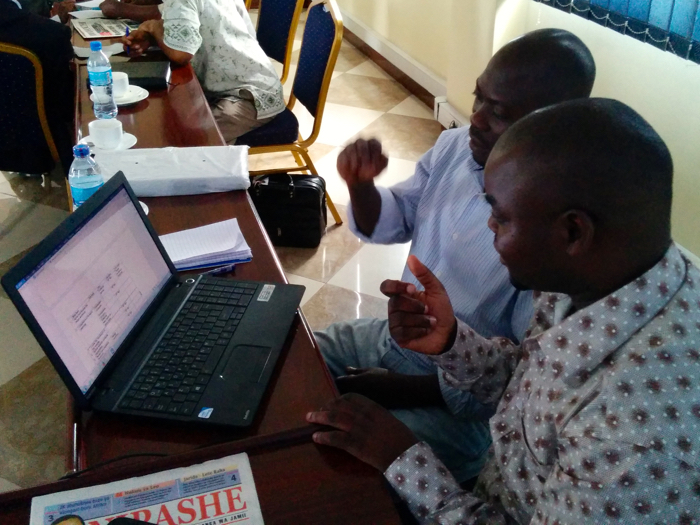
A journalist managing a news website is constantly involved in updating, refreshing and repositioning content in time with the evolving news flow.
This article was written for staff at a newspaper in Tanzania who had launched a news website and wanted to learn how to manage it.
Sections – where content lives
Each news item sits in one area of the news website. The story might belong in the technology section, the politics section, a world regional section, or some other area. Wherever it is, this is its home. Every story needs a home.
One of the skills of news website management is knowing how to display each story in all relevant sections, so that it appears on multiple section indices.
Take, for example, the news story that a study has revealed that users of mobile phones are exposed to an increased risk of developing cancer. Where should that story sit?
If it has come from a medical journal, it might be assigned to the health section as its primary home. If it is written by a technology expert, it might appear in the technical section.
Depending on the news angle, the story can be used in more than one section of the site. For example:
- Health: It is a health story, and users concerned about brain tumours (and who bookmark your health section) will expect to find it there.
- Technology: It is a technology story. Many will want to know what is being done to deal with the problem, such as what hands-free devices are available, or whether there are any shields on the market to protect people from the dangers.
- Business: It is a business story. Those with an interest in the mobile phone industry might be concerned about the effect the story has on shares of the leading mobile phone manufacturers.
- Regional news: The research might have come from an academic study attached to a university in a city in a country, so it is probably a regional news item, too.
This one story, about mobile phones being linked to cancer, can feature in the country-specific regional section and in the health, technology and business sections. It all depends on the focus.
It will not always be the same story – all depends on the focus and how it is written, but there will be some shared information. The story might be broken down into versions, each focussing on the angle of most concern to the section in which it appears. And all related stories should be cross-referenced with links.
However, it doesn’t end there. There will probably be some audio and video. If there is, the item could be the lead story in the multimedia section if you have one. Are there enough images to create a photo-gallery?
Will people want to discuss it? If so, it might be worth creating a discussion on the subject. It could become the biggest interactive issue of the day.
The role of the duty editor is to consider all these things. She or he has to ensure that all elements of the story are covered.
Expanding and developing stories
Another skill in running a news website is knowing when to break a story into component parts.
There will always be the need for one overview piece, but the duty editor needs to decide when it’s worth writing more detailed pieces about the various aspects of the story.
These news angles, once developed, will be added as related stories.
However, there is a danger in this. Don’t try to write a few hundred words on one minor development – this is padding. If it doesn’t justify a separate story, then don’t try to write one.
News specials
The duty editor might decide that an issue is of such significance, and is likely to be around for so long, that there is a need for a special section. This might include background information including fact files, timelines, profiles, question and answers.
As duty editor you might decide to have half-a-dozen themed sections a year to tie in with those being covered by TV, radio, or print. You might want to consider a few news specials highlighting big stories which are likely to crop up again and which you are likely to return to.
The benefit of a well-crafted collection of special sections is that they can be linked to in the future when a related news story breaks. This helps you to publish quality background information quickly. It helps your audience to understand the news story and gives it context. It also makes efficient use of archived material.
Data husbandry
Special sections can be of immense benefit because they group all news items, background information, and context and analysis pieces in one place. However, if you commission too many there is a danger that you might not be able to maintain them properly and they could soon become out of date.
This is particularly true with political specials. You will need to update the details of every politician who has resigned, moved on to another department, or died.
The best way round this is to treat your special sections as you would a garden. One day it looks beautiful, the next day weeds have grown and the flowers have gone to seed or died. You need to weed and tidy the garden regularly to keep it presentable. The same is true with news. Data husbandry is needed to ensure that the content in your special sections does not become out of date.
Again, using the analogy of the garden, some of the news features might need to be pruned or pulled out. Cuttings might need to be taken and replanted. Perhaps the whole special section needs digging over completely and a new design and arrangement offered.
Specials can rarely be left unattended; that is a recipe for disaster. The easiest way to manage this is not to have too many in the first place. You should also give one of your journalists responsibility for ensuring that the specials are always presentable. If a related news story breaks you will want to link to the special section immediately, not wait for a few hours while it is checked and given a makeover.
Special front page
There will be news stories that deserve a special front page. This is when the usual news site is taken over by something so important that no other stories deserve to make it through to the front page. Such stories will be obvious when they occur.
The attack on the twin towers on 9/11 might be considered such a news story. Special front pages might contain only one image, one headline, and one summary linking to one story.
There are two reasons for this. A minimal front page with one big story is less likely to crash at times of great user demand. It also sets out clearly that this is the most important news event happening at the time.
Just as important as knowing when to use a special front page is knowing when to take it down. A special front page limits the ability of the audience to find other information. Although they might be interested in the big story, they might also be interested in other material on the site. You might want to start thinking about removing the special front page and returning to normality after a couple of hours.
Legal issues
Be careful when covering legal cases where somebody has been arrested, faces charges, or is appearing in court. Somewhere on your site you may have covered the original incident, perhaps in some detail.
The story containing the background to the case might have been archived, but it will still be accessible via search. The user might also piece together the details and look up the case.
Your site will probably have material stored somewhere that could possibly influence a jury and perhaps lead to a contempt of court. Do not link to archived stories in an active case.
Exploiting content
The duty editor needs to talk to all outlets of the news operation on a regular basis in order to find out what material is available now, what is coming up, and when it will be ready for you to use online. They need to attend any daily meetings.
You might find that a particularly searching radio or TV interview can be cut into question-and-answer component parts. Perhaps you can make a text box for the front page highlighting the main questions. Those could link through to the answers in either audio, video, or text, or perhaps all three.
Knowing what material is available to you means that you can make best use of it online. You could have quote, film clip, image, and sound of the day. Everything you have can be cut up and used again in some other form.
This is important where you have different audiences tuning in at different times of the day to different programmes with different editorial focus. A news website presents an excellent opportunity to bring all the various elements together.
Every element can present you with another opportunity to help your audience better understand an issue. Clips or quotes from an interview could form the basis for an interactive forum discussion.
A guest, in the newsroom for a print, TV, or radio interview, might agree to stay for another hour for an online chat. If you know the day before that they are coming in, you can canvass users for their questions and put them to the guest.








